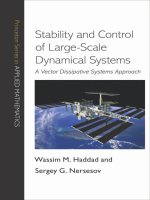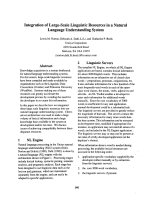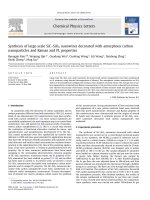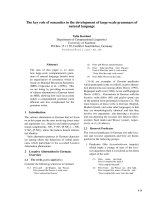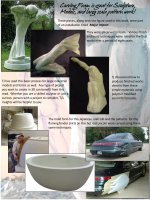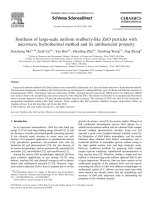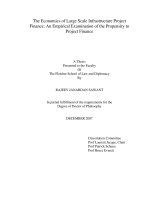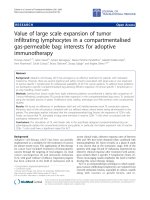Preconditioners for iterative solutions of large scale linear systems arising from biots consolidation equations
Bạn đang xem bản rút gọn của tài liệu. Xem và tải ngay bản đầy đủ của tài liệu tại đây (4.05 MB, 258 trang )
PRECONDITIONERS FOR
ITERATIVE SOLUTIONS OF LARGE-SCALE
LINEAR SYSTEMS ARISING FROM BIOT’S
CONSOLIDATION EQUATIONS
Chen Xi
NATIONAL UNIVERSITY OF SINGAPORE
2005
PRECONDITIONERS FOR
ITERATIVE SOLUTIONS OF LARGE-SCALE
LINEAR SYSTEMS ARISING FROM BIOT’S
CONSOLIDATION EQUATIONS
Chen Xi
(B.Eng.,M.Eng.,TJ U)
A THESIS SUBMITTED
FOR THE DEGREE OF DOCTOR OF PHILOSOPHY
DEPARTMENT OF CIVIL ENG INEERING
NATIONAL UNIVERSITY OF SINGAPORE
2005
i
ACKNOWL EDGEMENTS
I would like to thank my supervisor, Ass ociate Professor Phoon K ok Kwang, for his
continuous en courage, guidance and patience. Without his su pport and help during
this period, the accomplishment of the thesis could not be possible. I would like to
thank my co-supervisor, Associate Professor Toh Kim Chuan from the Department of
Mathematics (NUS ), for he has shared with me his vast knowledge and endless source
of ideas on preconditioned iterative methods . The members of my thesis committee,
Associate Professor Lee Fook Hou, Professor Quek Ser Tong and Associate Professor
Tan Siew Ann, deserve my appreciation for their advices on my thesis.
Thanks especially should be given to my family and my friends for their und ers tand-
ing. Though someone could be left unmentioned, I would like to mention a few: Duan
Wenhui and Li Yali deserve my acknowledgement for their help and encourage during the
struggling but wonderful days. Zhang Xiying also gave me great influence and deserve
my appreciation. I wish to thank Zhou Xiaoxian, Cheng Yonggang, and Li Liangbo for
the valuable discuss ions with them.
ii
TABLE OF CONTENTS
ACKN OWLEDGEMENTS i
TABLE OF CONTENTS ii
SUMMARY vii
LIST OF TABLES ix
LIST OF FIGURES xi
LIST OF SYMBOLS xiv
DEDICATION xx
1 INTRODUCTION 1
1.1 Preconditioned Iterative Solutions in Geotechnical Problems . . . . . . . . 2
1.2 Preconditioned Iterative Solutions in Biot’s Consolidation Problems . . . 3
1.3 Objectives and Significance . . . . . . . . . . . . . . . . . . . . . . . . . . 6
1.4 Computer Software and Hardware . . . . . . . . . . . . . . . . . . . . . . 7
1.5 Organization . . . . . . . . . . . . . . . . . . . . . . . . . . . . . . . . . . 8
2 OVERVIEW OF PRECONDITIONED ITERATIVE METHODS FOR
LINEAR SYSTEMS 9
2.1 Overview of I terative Methods . . . . . . . . . . . . . . . . . . . . . . . . 11
2.1.1 Stationary Iterative Method s . . . . . . . . . . . . . . . . . . . . . 12
2.1.2 Non-stationary Iterative Methods . . . . . . . . . . . . . . . . . . . 15
2.2 Overview of P reconditioning Techniques . . . . . . . . . . . . . . . . . . . 23
2.2.1 Diagonal Preconditioning . . . . . . . . . . . . . . . . . . . . . . . 25
iii
2.2.2 SSOR Preconditioning . . . . . . . . . . . . . . . . . . . . . . . . . 26
2.2.3 Block Preconditioning . . . . . . . . . . . . . . . . . . . . . . . . . 27
2.2.4 Incomplete Factorization Preconditioning . . . . . . . . . . . . . . 29
2.2.5 Approximate Inverse Preconditioning . . . . . . . . . . . . . . . . 32
2.2.6 Other Preconditioning Methods . . . . . . . . . . . . . . . . . . . . 33
2.3 Data Storage Schemes . . . . . . . . . . . . . . . . . . . . . . . . . . . . . 33
2.4 Summary . . . . . . . . . . . . . . . . . . . . . . . . . . . . . . . . . . . . 37
3 ITERATIVE SOLUTIONS FOR BIOT’S SYMMETRIC INDEFINITE
LINEAR SYSTEMS 43
3.1 Introduction . . . . . . . . . . . . . . . . . . . . . . . . . . . . . . . . . . . 43
3.2 Linear Systems Discretized from Biot’s Consolidation Equations . . . . . 45
3.2.1 Biot’s Consolidation Equations . . . . . . . . . . . . . . . . . . . . 45
3.2.2 Spatial Discretization . . . . . . . . . . . . . . . . . . . . . . . . . 48
3.2.3 Time Integration . . . . . . . . . . . . . . . . . . . . . . . . . . . . 50
3.3 Partitioned Iterative Methods . . . . . . . . . . . . . . . . . . . . . . . . . 52
3.3.1 Stationary Partitioned I terative Methods . . . . . . . . . . . . . . 53
3.3.2 Nonstationary Partitioned Iterative Methods . . . . . . . . . . . . 55
3.4 Global Krylov Subspace Iterative Methods . . . . . . . . . . . . . . . . . . 58
3.5 Preconditioning Strategies . . . . . . . . . . . . . . . . . . . . . . . . . . . 59
3.6 Numerical Examples . . . . . . . . . . . . . . . . . . . . . . . . . . . . . . 61
3.6.1 Convergence Criteria . . . . . . . . . . . . . . . . . . . . . . . . . . 61
3.6.2 Problem Descriptions . . . . . . . . . . . . . . . . . . . . . . . . . 62
3.6.3 Numerical Results . . . . . . . . . . . . . . . . . . . . . . . . . . . 62
3.7 Conclusions . . . . . . . . . . . . . . . . . . . . . . . . . . . . . . . . . . . 65
4 BLOCK CONSTRAINED VERSUS GENERALIZED JACOBI PRE-
CONDITIONERS 74
4.1 Introduction . . . . . . . . . . . . . . . . . . . . . . . . . . . . . . . . . . . 74
4.2 Block Constrained Preconditioners . . . . . . . . . . . . . . . . . . . . . . 76
4.2.1 Overview . . . . . . . . . . . . . . . . . . . . . . . . . . . . . . . . 76
4.2.2 Implementation Details . . . . . . . . . . . . . . . . . . . . . . . . 77
4.3 Numerical Examples . . . . . . . . . . . . . . . . . . . . . . . . . . . . . . 80
iv
4.3.1 Convergence Criteria . . . . . . . . . . . . . . . . . . . . . . . . . . 80
4.3.2 Problem Descriptions . . . . . . . . . . . . . . . . . . . . . . . . . 80
4.3.3 Comparison Between GJ and P
c
. . . . . . . . . . . . . . . . . . . 81
4.3.4 Eigenvalue Distribution of Preconditioned Matrices and Conver-
gence Rates . . . . . . . . . . . . . . . . . . . . . . . . . . . . . . . 82
4.4 Conclusions . . . . . . . . . . . . . . . . . . . . . . . . . . . . . . . . . . . 84
5 A MODIFIED SSOR PRECONDITIONER 96
5.1 Introduction . . . . . . . . . . . . . . . . . . . . . . . . . . . . . . . . . . . 96
5.1.1 The GJ Preconditioner . . . . . . . . . . . . . . . . . . . . . . . . . 97
5.1.2 The P
c
Preconditioner . . . . . . . . . . . . . . . . . . . . . . . . . 98
5.2 Modified SSOR preconditioner . . . . . . . . . . . . . . . . . . . . . . . . 98
5.2.1 Derivation of a New Modified Block SSOR Preconditioner . . . . . 99
5.2.2 A New Modified Pointwise SSOR Preconditioner . . . . . . . . . . 100
5.2.3 Combining With Eisenstat Trick . . . . . . . . . . . . . . . . . . . 101
5.2.4 Other Implementation Issues of GJ, P
c
and P
MSSOR
. . . . . . . 104
5.3 Numerical Experiments . . . . . . . . . . . . . . . . . . . . . . . . . . . . 105
5.3.1 Convergence Criteria . . . . . . . . . . . . . . . . . . . . . . . . . . 105
5.3.2 Problem Descriptions . . . . . . . . . . . . . . . . . . . . . . . . . 106
5.3.3 Choice of Parameters in GJ(MSSOR) and Eigenvalue Distributions
of GJ(MSSOR) Preconditioned Matrices . . . . . . . . . . . . . . . 107
5.3.4 Performance of MSSOR versus GJ and P
c
. . . . . . . . . . . . . . 109
5.4 Conclusions . . . . . . . . . . . . . . . . . . . . . . . . . . . . . . . . . . . 111
6 NEWTON-KRYLOV ITERATIVE METHODS FOR LARGE -SCALE
NONLINEAR CONSOLIDATION 127
6.1 Introduction . . . . . . . . . . . . . . . . . . . . . . . . . . . . . . . . . . . 127
6.2 Nonlinearity of FE Biot’s Consolidation Equations . . . . . . . . . . . . . 129
6.3 Incremental Stress-Strain Relations . . . . . . . . . . . . . . . . . . . . . . 130
6.4 Backward Euler Return Algorithm . . . . . . . . . . . . . . . . . . . . . . 133
6.5 Modified Cam Clay Model . . . . . . . . . . . . . . . . . . . . . . . . . . . 135
6.6 von Mises Model . . . . . . . . . . . . . . . . . . . . . . . . . . . . . . . . 138
6.7 Global Newton-Krylov Iteration in Finite Element Implementation . . . . 138
v
6.8 Numerical Examples . . . . . . . . . . . . . . . . . . . . . . . . . . . . . . 140
6.8.1 Convergence Criteria . . . . . . . . . . . . . . . . . . . . . . . . . . 140
6.8.2 Problem Descriptions . . . . . . . . . . . . . . . . . . . . . . . . . 140
6.8.3 Numerical Results . . . . . . . . . . . . . . . . . . . . . . . . . . . 141
6.9 Conclusions . . . . . . . . . . . . . . . . . . . . . . . . . . . . . . . . . . . 142
7 CONCLUSIONS & FUTURE WORK 148
7.1 Summary and Conclusions . . . . . . . . . . . . . . . . . . . . . . . . . . . 148
7.2 Future Work . . . . . . . . . . . . . . . . . . . . . . . . . . . . . . . . . . 152
REFERENCES 154
A SOME ITERATIVE ALGORITHMS AND CONVERGENCE CRITE-
RIA 168
A.1 Algorithms for PCG and SQMR . . . . . . . . . . . . . . . . . . . . . . . 168
A.2 Convergence Criteria for Iterative Methods . . . . . . . . . . . . . . . . . 169
B SPARSE MATRIX TECHNIQUES 174
B.1 Storage S chemes for Sparse Matrix . . . . . . . . . . . . . . . . . . . . . . 174
B.1.1 Some Popular Storages . . . . . . . . . . . . . . . . . . . . . . . . . 174
B.1.2 Demonstration on How to Form Symmetric Compressed Sparse
Storage . . . . . . . . . . . . . . . . . . . . . . . . . . . . . . . . . 175
B.1.3 Adjacency Structure for Sparse Matrix . . . . . . . . . . . . . . . . 179
B.2 Basic Sparse Matrix Operations . . . . . . . . . . . . . . . . . . . . . . . . 180
C SOURCE C ODES IN FORTRAN 90 182
C.1 Main Program for 3-D Biot’s Consolidation FEM Analysis . . . . . . . . . 182
C.2 New Subroutines for Module new library . . . . . . . . . . . . . . . . . 189
C.3 A New Module sparse lib . . . . . . . . . . . . . . . . . . . . . . . . . . 192
C.4 How to Use sparse lib in FEM Package . . . . . . . . . . . . . . . . . . 215
C.4.1 Introduction . . . . . . . . . . . . . . . . . . . . . . . . . . . . . . 215
C.4.2 Three Basic Components in sparse lib . . . . . . . . . . . . . . . 215
C.4.3 Parameters or Basic Information for sparse lib Library . . . . . 216
C.4.4 Flowchart of Using sparse lib Library . . . . . . . . . . . . . . . 220
vi
C.4.5 Demonstration of Using sparse lib in Program p92 . . . . . . . 221
C.4.6 An Improved Version of sparse lib . . . . . . . . . . . . . . . . . 230
vii
SUMMARY
The solution of the linear systems of equation is the mos t time-consuming part in large-
scale finite element analysis. The development of efficient solution methods are therefore
of utmost importance to the field of scientific compu ting. Recent advances on solution
methods of linear systems show that Krylov subs pace iterative methods have greater
potentials than direct solution methods for large-scale linear systems. However, to be
successful, a Krylov subspace iterative method should be used with an efficient precon-
ditioning method.
The objective of this thesis was to investigate the efficient pr econditioned iterative
strategies as well as to develop robust preconditioning methods in conjunction w ith suit-
able iterative methods to solve very large symmetric or weakly nonsymmetric (which
is assumed to be symmetric) indefinite linear systems arising from the coupled Biot’s
consolidation equations. The efficient preconditioned iterative schemes for large non-
linear consolidation p roblems also deserve to be studied. It was well known that the
linear systems discretized from Biot’s consolidation equations are usually symmetric in-
definite, but in some cases, they could be weakly nonsymmetric. However, irrespective
of which case, Symmetric Quasi-Minimal Residual (SQMR) iterative method can be
adopted. To accelerate the convergence of SQMR, a block constrained preconditioner
P
c
which was prop osed by Toh et al. (2004) recently was used and compared to Gen-
eralized Jacobi (GJ) preconditioner (e.g. Phoon e t al., 2002, 2003). P
c
preconditioner
has the same block structure as that of the original stiffness matrix, but with the (1, 1)
block replaced by a diagonal approximation. As a further development of P
c
, a Modi-
fied Symmetric Successive Over-Relaxation (MSSOR) preconditioner wh ich m odifies the
diagonal parts of standard SSOR from a theoretical perspective was developed. The
widely investigated numerical experiments show that MSSOR is extremely suitable for
large-scale consolidation problems with highly varied soil properties. To solve the large
viii
nonlinear consolidation problems, Newton-Krylov (more accurately, Newton-SQMR) was
proposed in conjunction with GJ and MSSOR preconditioners. Numerical experiments
were carr ied out based on a series of large problems with different mesh sizes an d also on
more demanding heterogeneous soil conditions. For large nonlinear consolidation prob-
lems bas ed on modified Cam clay model and ideal von Mises model, the performance
of the Newton-SQMR method with GJ and MSSOR preconditioners was compared to
Newton-Direct solution method and the so-called composite Newton-SQMR method with
P
B
(e.g. Borja, 1991). Numerical results indicated that Newton-Krylov was very suitable
for large nonlinear problems and both GJ and MSSO R preconditioners resulted in faster
convergence of SQMR solver than available efficient P
B
preconditioner. In particular,
MSSOR was extremely robust for large computations of coupled problems. It could been
expected that the new developed MSSOR preconditioners can be readily extended to
solve large-scale coupled problems in other fields.
Keywords: Biot’s consolidation equation, nonlinear consolidation, three-dimensional
finite element analysis, symmetric indefinite linear system, iterative solution, Newton-
Krylov, quasi-minimal residual (QMR) method, block preconditioner, modified SSOR
preconditioner
ix
LIST OF TABLES
2.1 EBE technique versus sparse techn ique . . . . . . . . . . . . . . . . . . . . 42
3.1 3-D finite element meshes . . . . . . . . . . . . . . . . . . . . . . . . . . . 69
3.2 Performance of stationary partitioned iterations (ξ = 1.0, η = 1.0) over
mesh refining. . . . . . . . . . . . . . . . . . . . . . . . . . . . . . . . . . . 70
3.3 Performance of Prevost’s inner-outer PCG method over mesh refining . . 71
3.4 Performance of preconditioned by GJ(+4) method over mesh refining for
homogeneous problems. . . . . . . . . . . . . . . . . . . . . . . . . . . . . 72
3.5 Performance of GJ(−4) method over m esh refin ing for homogeneous prob-
lems. . . . . . . . . . . . . . . . . . . . . . . . . . . . . . . . . . . . . . . . 73
4.1 3-D finite element meshes . . . . . . . . . . . . . . . . . . . . . . . . . . . 93
4.2 Performance of the GJ preconditioner over different mesh sizes and s oil
properties . . . . . . . . . . . . . . . . . . . . . . . . . . . . . . . . . . . . 94
4.3 Performance of the P
c
preconditioner over different mesh sizes and soil
properties . . . . . . . . . . . . . . . . . . . . . . . . . . . . . . . . . . . . 95
5.1 3-D finite element meshes . . . . . . . . . . . . . . . . . . . . . . . . . . . 121
5.2 Effect of orderin g on MS SOR(ω = 1, α = −4) preconditioned SQMR
method. . . . . . . . . . . . . . . . . . . . . . . . . . . . . . . . . . . . . . 122
5.3 Effect of α on iterative count of MSSOR(ω = 1.0) preconditioned SQMR
method . . . . . . . . . . . . . . . . . . . . . . . . . . . . . . . . . . . . . 123
5.4 Effect of ω on iterative count of standard SSOR and MSSOR(α = −50)
preconditioned SQMR methods, respectively. . . . . . . . . . . . . . . . . 123
5.5 Performance of several p reconditioners over different mesh sizes for soil
profile 1 with homogen eous soft clay, E
′
= 1 MPa, ν
′
= 0.3, k = 10
−9
m/s. 124
x
5.6 Performance of several p reconditioners over different mesh sizes for soil
profile 2 with homogeneous dense sand, E
′
= 100 MPa, ν
′
= 0.3, k = 10
−5
m/s. . . . . . . . . . . . . . . . . . . . . . . . . . . . . . . . . . . . . . . 125
5.7 Performance of several p reconditioners over different mesh sizes for soil
profile 3 with alternative soil properties E
′
= 100 MPa, ν
′
= 0.3, k = 10
−5
m/s and E
′
= 1 MPa, ν
′
= 0.3, k = 10
−9
m/s . . . . . . . . . . . . . . . . 126
6.1 Parameters of modified Cam clay model. . . . . . . . . . . . . . . . . . . . 145
6.2 Parameters of von Mises model. . . . . . . . . . . . . . . . . . . . . . . . . 145
6.3 Nonlinear consolidation analysis based on 8 × 8 × 8 finite element mesh
(DOFs = 7160) and modified Cam clay model. . . . . . . . . . . . . . . . 145
6.4 Nonlinear consolidation analysis based on 8 × 8 × 8 finite element mesh
(DOFs = 7160) and von Mises model. . . . . . . . . . . . . . . . . . . . . 146
6.5 Nonlinear consolidation analysis based on 12 ×12×12 finite element mesh
(DOFs = 23604) and modified Cam clay model. . . . . . . . . . . . . . . . 146
6.6 Nonlinear consolidation analysis based on 12 ×12×12 finite element mesh
(DOFs = 23604) and von Mises model. . . . . . . . . . . . . . . . . . . . . 147
xi
LIST OF FIGURE S
2.1 Flowchart on the selection of preconditioned iterative methods . . . . . . 38
2.2 Sparsity pattern of matrices after reordering. . . . . . . . . . . . . . . . . 39
2.3 Sparsity pattern of matrices after block reordering. . . . . . . . . . . . . . 40
2.4 Flow chart of applying sparse preconditioned iterative method in FEM
analysis . . . . . . . . . . . . . . . . . . . . . . . . . . . . . . . . . . . . . 41
3.1 Eigenvalue distribution of stiffness matrix A (m = 1640, n = 180) of Biot’s
linear system. . . . . . . . . . . . . . . . . . . . . . . . . . . . . . . . . . . 66
3.2 20×20×20 finite element mesh of a quadrant symmetric shallow foundation
problem. . . . . . . . . . . . . . . . . . . . . . . . . . . . . . . . . . . . . . 67
3.3 Convergence history of GJ(α = −4.0) preconditioned coupled iterative
methods, solid line is for PCG and SQMR methods, while dashed line is
for MINRES method; (a). Homogeneous problem with soil profile 1; (b)
Homogeneous problem with soil profile 2. . . . . . . . . . . . . . . . . . . 68
4.1 24×24×24 finite element mesh of a quadrant symmetric shallow foundation
problem. . . . . . . . . . . . . . . . . . . . . . . . . . . . . . . . . . . . . . 86
4.2 (a) Iteration count as a percentage of DOFs, and (b) Comparison of itera-
tion count between GJ and P
c
“Material 1” and“Material 2” refers to soft
clays and dense sands, respectively). . . . . . . . . . . . . . . . . . . . . . 87
4.3 (a) Rate of increase in overhead with DOFs, (b) Rate of increase in
time/iteration with DOFs, (c) Total runtime ratio between P
c
and GJ,
and (d) Total/iteration time ratio between P
c
and GJ (“Material 1” and
“Material 2” refers to soft clays and dense sands, resp ectively). . . . . . . 88
4.4 Rate of increase in RAM usage during iteration with DOFs. . . . . . . . . 89
xii
4.5 Convergence history of relative residual norms for SQMR solution of 5 ×
5 × 5 meshed footing problem . . . . . . . . . . . . . . . . . . . . . . . . . 90
4.6 Eigenvalue distribution of: (a) GJ-precondtioned matrix and (b) P
c
-precondtioned
matrix. . . . . . . . . . . . . . . . . . . . . . . . . . . . . . . . . . . . . . . 91
4.7 A polygonal region that approximately contains the eigenvalues of the
GJ-precondtioned matrix. . . . . . . . . . . . . . . . . . . . . . . . . . . . 92
5.1 7 × 7 ×7 finite element mesh for simple footing problem. . . . . . . . . . . 112
5.2 20 × 20 ×20 finite element mesh and soil layer profile of a quadrant sym-
metric shallow foundation problem. . . . . . . . . . . . . . . . . . . . . . . 113
5.3 Eigenvalue distributions in complex plane (a) of GJ (α = −4) precon-
ditioned matrix; (b) of GJ (α = −20) preconditioned matrix; (c) of P
c
preconditioned matrix, for 7 ×7 ×7 FE mesh with soil profile 1. . . . . . 114
5.4 Eigenvalue distributions in complex plane of MSSOR preconditioned ma-
trices (a) MSSOR (α = −4, ω = 1.0); (b) MSSOR (α = −20, ω = 1.0);
(c) MSSOR (α = −20, ω = 1.3). . . . . . . . . . . . . . . . . . . . . . . . 115
5.5 Convergence history of SQMR method preconditioned by GJ (α = −4),
P
c
, SSOR (ω = 1.0) and MSSOR (α = −4, ω = 1.0), respectively, for
7 × 7 × 7 finite element mesh (a) with soil profile 1 (solid line) and with
soil profile 2 (dashed line), respectively; (b) with soil profile 3. . . . . . . . 116
5.6 Iteration count versus DO Fs for SQMR method preconditioned by GJ
(α = −4), P
c
and MSSOR (α = −4, ω = 1.0), respectively for three soil
profile (SP) cases. . . . . . . . . . . . . . . . . . . . . . . . . . . . . . . . . 117
5.7 Time per iteration versus DOFs for SQMR method preconditioned by GJ
(α = −4), P
c
and MSSOR (α = −4, ω = 1.0) for three soil profile cases. . 118
5.8 Uniform 20 ×20 ×20 finite element mesh with ramp loading . . . . . . . 119
5.9 Results for parallel computing versus desktop PC . . . . . . . . . . . . . . 120
6.1 3-D 8 × 8 ×8 finite element mesh of a quadrant sym metric shallow foun-
dation with ramp loading P. . . . . . . . . . . . . . . . . . . . . . . . . . 143
6.2 Vertical settlements at point “A” with time steps. . . . . . . . . . . . . . 144
B.1 CSC storage of matrix A and CSC storage of its upper triangular part. . . 175
xiii
B.2 Adjacency structure for matrix A of Equation (B.1) . . . . . . . . . . . . 179
xiv
LIST OF SYMBOLS
⊥ Orthogonality
{·} A vector
(·, ·) Inner product of two vectors
|·| Absolute value or modulus of a number
· Some kind of norm
·
2
2-norm
0 Zero vector
1 Second-order Kronecker delta in vectorial form
2-D 2-dimensional
3-D 3-dimensional
a Gradient to the yield surface
A Coefficient matrix or coupled stiffness matrix
AMD Approximate minimal degree
b Right hand side vector
b Vector b = {0, 0, 1}
T
or the gradient to plastic potential
b
w
Bo dy force vector of pore fluid
b
s
Bo dy force vector of soil skeleton
B
p
Derivative matrix of N
p
about coordinates
B
u
Strain-displacement matrix
BE Boundary element
BFGS Broyden-Fletcher-Goldfarb-Shanno
Bi-CG Biconjugate gradient
Bi-CGSTAB Biconjugate gradient stablized
c Gradient of plastic potential to internal variable
CG Conjugate Gradient
CGNE CG for normalized equation with A
T
multiplied from right
xv
CGNR CG for normalized equation with A
T
multiplied from left
CGS Conjugate gradient squared
CPU Central p rocessing unit
CSC Compress Sparse Column
CSR Compress Sparse Row
D Strictly diagonal part of a matrix
D Block diagonal p art of a matrix
D
e
Elastic stress-strain matrix
D
ep
Elasto-plastic s tress-strain matrix
D
epc
Consistent tangent matrix
D
p
Plastic stress-strain matrix
D-ILU Diagonal ILU
diag(·) Diagonal matrix of a matrix
div(·) Divergence
e
i
e
i
= {0, . . . , 1
i−th
, . . . , 0}
T
e
k
Error vector defined by e
k
= x − x
k
E
′
Effective Youn g’s modulus
EBE Element-by-element
f L oad vector or yield surface function
f Load vector
flops The number of floating point operations
g Fluid flux or plastic potential function
G Global fluid stiffness matrix
G
e
Element fluid stiffness matrix
G
′
Elastic shear modulus
GJ Generalized Jacobi
GMRES Generalized minimal residual
H Hessenberg matrix or preconditioning matrix
I Identity matrix
I
d
The deviatoric component in I
I
v
The volumetric component in I
IC Incomplete Cholesky
ICCG Incomplete Cholesky preconditioned conjugate gradient
xvi
ILU Incomplete LU
ILUM Multi-elimination ILU
ILUT Incomplete LU with dual threshold
J J matrix
K Global soil stiffness matrix
K
e
Element soil stiffness matrix
K
′
Elastic bulk modulus
K
k
k-th Krylov subspace
[k] Permeability matrix
L Strictly lower triangular part of a matrix
L Global connection or coupled matrix
L
e
Element connection or coupled matrix
L Block lower triangular part of a matrix
M Preconditioning matrix or slope of the critical state line
M
Jac
Jacobi iteration matrix
M
GS
Gauss-Seidel iteration matrix
M
SOR
SOR iteration matrix
M
SSOR
SSOR iteration matrix
max it Permitted maximum iteration number
MD Minimal degree
MINRES Minimal residual
MJ Modified Jacobi
MMD Multiple minimal degree
MSSOR Modified symmetric successive over-relaxation
n Dimension of a matrix
n Unit outward normal
N
p
Pore pressure shape function vector for fluid element
N
u
Displacement shape function matrix for solid element
ND Nested Dissertation
nnz(·) The number of nonzero entr ies of a matrix
p Total pore water pressure with p = p
st
+ p
ex
P Permutation or reordering matrix
p
′
Mean effective stress
xvii
p
′
c
Preconsolidation pressure
p
e
Vector of element nodal pore water pressure
p
st
Static pore water pressure
p
ex
Excess pore water pressure
P
c
Block constrained preconditioner
P
d
Block diagonal preconditioner
P
GJ
Generalized Jacobi p reconditioner
P
MJ
Modified Jacobi preconditioner
P
MBSSOR
Modified block SSOR preconditioner
P
MSSOR
Modified SSOR preconditioner
P
SSOR
SSOR preconditioner
P
t
Block triangular preconditioner
P
k
(·) A k-degree polynomial satisfying P
k
(0) = 1
PCG Preconditioned conjugate gradient
PCR Preconditioned conjugate residual
q Deviatoric stress
q Vector of internal variable
Q
j
(·) A j-degree polynomial satisfying Q
j
(0) = 1
QMR Quasi-minimal residual
QMR-CGSTAB Quasi-minimal residual variant of the Bi-CGSTAB algorithm
r Residual vector
R Set of real numbers
R
n
vector space of real n-vectors
R
n×n
vector space of real n-by-n matrices
RAM Random access memory
RCM Reverse Cu th ill-McKee
s Shadow residual vector or stress deviator
S Schur complement matrix
S Sparsity set of a matrix
S
e
Element surface boundary domain
SJ Standard Jacobi
SOR Successive over-relaxation
SPAI Sparse approximate inverse
xviii
span{···} Space spanned by the given vectors
SPD Symmetric positive definite
SQMR Symmetric quasi-minimal residual
SSOR Symmetric successive over-relaxation
stop tol Preset convergence tolerance
SYMMLQ Symmetric LQ
t Vector of surface traction force
T Tridiagonal matrix
tr(·) Trace of a vector
u Global no dal displacement vector
u
e
Nodal displacement vector for solid element
U Strictly upper triangular part of a matrix
U Block lower triangular part of a matrix
v A vector
v Vector of superficial fluid velo city, v = {v
x
, v
y
, v
z
}
T
V
e
Element volume domain
w
p
Weighting scalar for pore pressure
w
u
Weighting function vector for displacement
x Solution vector or local spatial coordinate
α Real number or scaler
β Real number or scalar
γ Real number or scalar
γ
w
Unit weight of pore water
γ
s
Unit weight of soil
δ Small change in one variable
∆ Increment of one variable
∆λ Plastic multiplier
dλ Differential of ∆λ
ε
v
Volumetric strain
ε Strain vector
ε
e
Elastic component of ε
ε
p
Plastic component of ε
ζ Real scalar
xix
η Real relaxation parameter
θ Time integration parameter
ϑ A scalar
κ The swelling or recompression index
λ The eigenvalue of a matrix
ν
′
Effective Poisson’s ratio
Continuous product
ρ(·) The spectral radius of a matrix
̺ a scalar with the value, ̺ = r
0
σ
′
Effective stress vector
σ
′
i
Normal effective stress in i-direction (i = x, y, z)
τ
i
Shear stress in i-direction (i = xy, yz, zx)
ξ Real relaxation parameter
χ The virgin compression index
Φ Schwaz-Christoffel map
ω Relaxation parameter or the weighted average parameter
ω
opt
Optimal relaxation parameter
Summation
∇ A differential operator
Integration in some kind of domain
⊗ Tensor product
¯
· Permuted matrix
· Approximation of a matrix or a matrix with threshold
· Preconditioned matrix
xx
To my family
CHAPTER 1
INTRODUCTION
With the rapid developments of computer an d computational technology, ordinary desk-
top computers have been widely used to solve engineering problems by scientists and
engineers. It is well known that in finite element (FE) software packages, the solution
of linear systems is one of the three classes of computationally intensive processes
1
(e.g.
Smith, 2000). The solution of linear equations has received significant attentions because
fast and accurate solution of linear equations is essential in engineering problems and sci-
entific computing. Traditionally, direct solution methods are preferred to linear system
of equations.
A general form of linear system can be given as
Ax = b, A ∈ R
n×n
and x, b ∈ R
n
(1.1)
It is uncertain whether direct solutions or iterative solutions are better because the
bound aries between these two main classes of methods have become increasingly blurred
(e.g. Benzi, 2002). However, as a result of recent advances of iterative methods and
preconditioning techniques in scientific computing and engineering, more applications
are turning to iterative solutions for large-scale linear sy s tems arisin g from geotechnical
engineering.
The traditional way to solve a non-singular squ are linear system is to employ direct
solution methods or its variants which are based on the classical Gaus s ian elimination
scheme. These direct methods can lead to the exact solution in the abs en ce of roundoff
1
The three classes of computationally expensive process are solution of linear equations, solution of
eigenvalue equations and integration of ordinary differential equations in time domain
1.1: Preconditioned Iterative Solutions in Geotechnical Problems 2
errors. However, especially for large sparse linear systems arisin g from 3-D problems,
direct solution methods may incur a large number of fill-ins, and the large order n of
the matrix makes it expensive to spend about n
3
floating point operations (additions,
subtractions and multiplications) to solve such a large linear system. Therefore, for
direct solution methods, the computing cost and memory requirement increase signifi-
cantly with the prob lem size. On the contrary, iterative solution methods are becoming
attractive for such large-scale linear equations because only matrix-vector products and
inner-products are required in the iteration process.
1.1 Preconditioned Iterative Solutions in Geotechnical Prob-
lems
In recent years, preconditioned iterative metho ds h ave been used for some geotechnical
problems. Wang (1996) successfully used element-by-element (EBE) based Precondi-
tioned Conjugate Gradient (PCG) method to solve very large 3-D finite element pile
groups and pile-rafts problems. The author also studied the characteristics of PCG in
elasto-plastic analysis and concluded that although the PCG metho d was about 30%
slower than the direct method for plastic analysis at that time, but he was very confident
that with some improvements, PCG can be made faster in plastic analysis in the future.
Payer and Mang (1997) proposed two iterative schemes to perform boundary-element
(BE) and hybrid BE-FE simulation of excavations for tunneling. The investigated it-
erative methods were Generalized Minimum Residu al (GMRES), Conjugate Gradient
Square (CGS) and Stabilized Bi-CG (Bi-CGSTAB) preconditioned by diagonal scaling,
Symmetric Successive Over-Relaxation (SSOR) as well as incomplete factorization, re-
spectively. Hlad´ık et al. (1997) suggested replacing direct solutions by preconditioned
iterative methods in finite element packages. They tested Conjugate Gradient (CG)
solver preconditioned by two different forms of preconditioners: one is global Incomplete
Cholesky (IC) type preconditioners and the other is symmetrically scaled EBE based
preconditioners. However, it was proved that the proposed EBE based preconditioner is
less efficient than IC on a serial computer, but EBE storage is easily adapted to paral-
lel computing. A range of numerical examples from geotechnical en gineering problems
1.2: Preconditioned Iterative Solutions in Biot’s Consolidation Problems 3
showed that the Robust Incomplete Cholesky (RIC) preconditioner with a near-optimal
choice of the relaxation parameter can be very efficient and reliable for practical 2-D and
3-D geotechnical problems in elasticity. Smith and Wang (1998) analyzed the piled rafts
in their full three-dimensional complexity by P CG solver, but the numerical experiments
were carried out on a parallel computer with the “element-by-element” or “mesh-free”
strategies. By means of these strategies, the need to assemble the global coefficient ma-
trix is removed. Kayupov et al. (1998) used CGS and GMRES iterative methods with
simple Jacobi p reconditioning to enhance Indir ect Boundary Element Method (IBEM)
for underground construction problems. They concluded that CGS and GMRES with
simple Jacobi preconditioning appeared to be efficient and robust. By using sparse iter-
ative methods, Mroueh and Shahrour (1999) studied the resolution of three-dimensional
soil-structure interaction problems: a shallow foundation under a vertical flexible load-
ing, a single pile subjected to a lateral loading and construction of a lined tunnel in soft
ground. Because the elastic-perfectly plastic Mohr-Coulomb model was assumed for the
soil materials, the resulting linear systems being nonsymmetric or symmetric depends
on w hether the plastic flow is non-associated or associated. For the sparse linear sys-
tems arising from these interaction problems, Bi-CG, Bi-CGSTAB, QMR-CGSTAB have
been used, and the performances of SSOR and Jacobi preconditioners are investigated
and compared. Numerical results show that left preconditioned SSOR preconditioner
gives better performance compared to Jacobi preconditioner for the resolution of soil-
structure interaction problems with high varied material heterogeneity and plasticity.
Furthermore, for a full 3-D fi nite element analysis of the interaction between tunnels and
adjacent structures, the authors proposed to use sparse Bi-CGSTAB solver coupled with
the SSOR preconditioning.
1.2 Preconditioned Iterative Solutions in Biot’s Consolida-
tion Problems
In geotechnical engineering, the solution of Biot’s consolidation problems has played an
essential role since the pioneer work of Terzaghi (1925) and Biot (1941). To calculate soil
settlement accompanied with dissipating pore water pressure, Terzaghi (1925) developed
